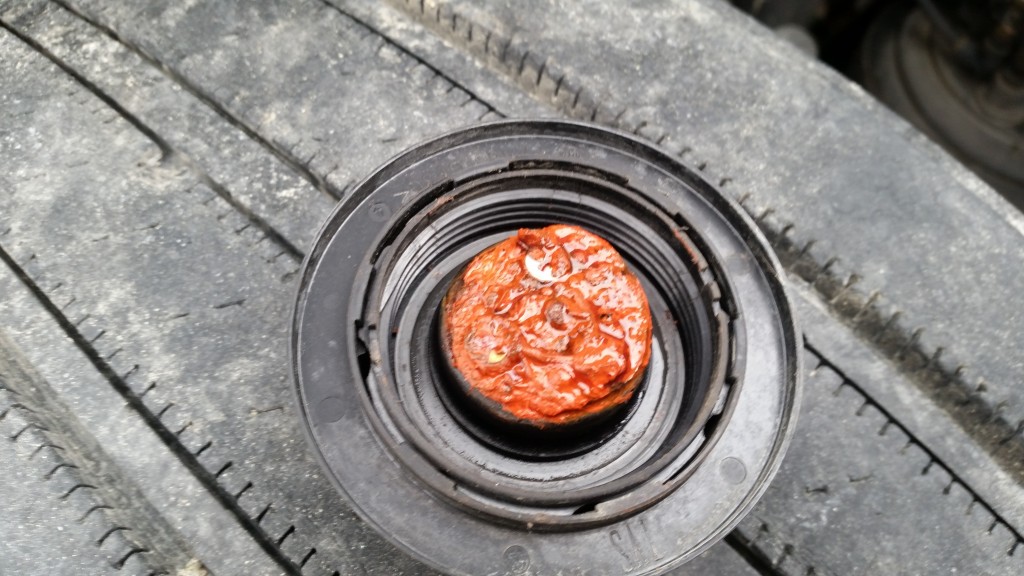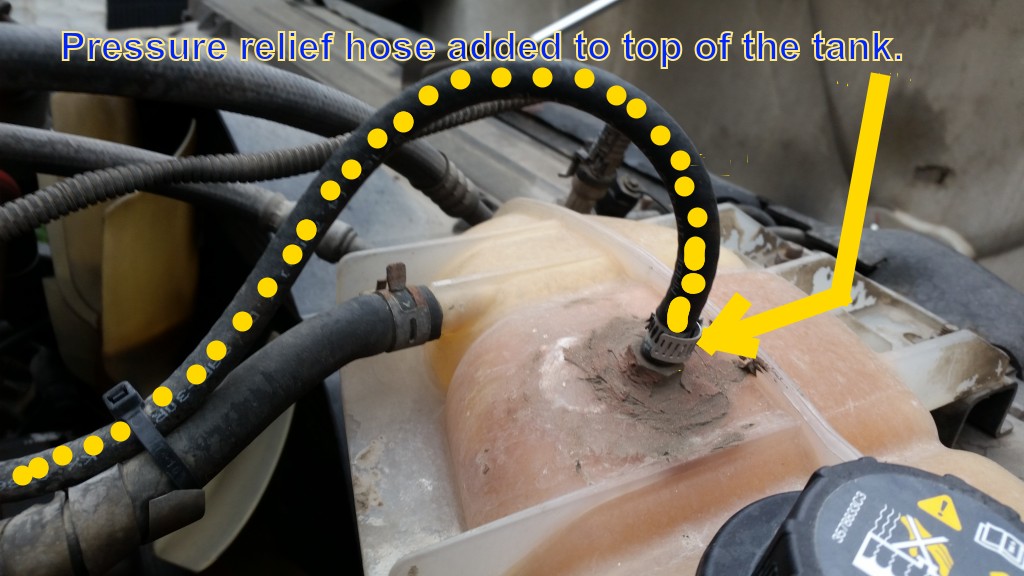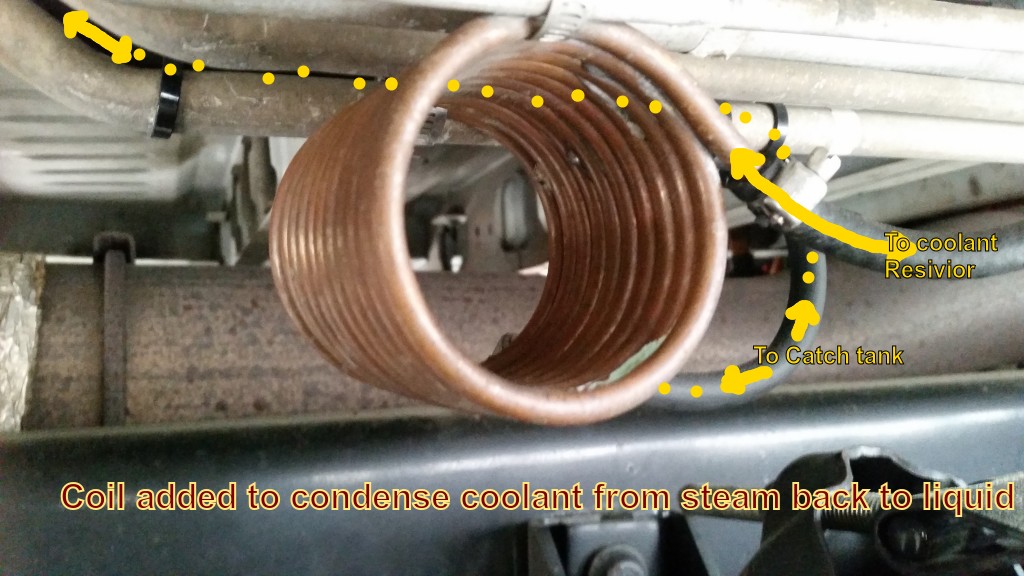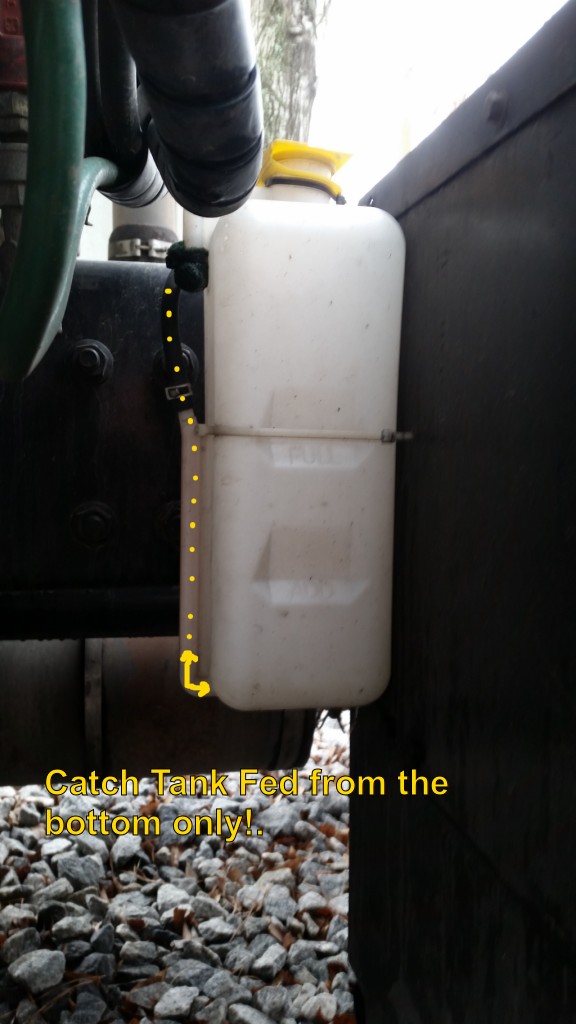| Zero pressure cooling system |
| 03-12-2017, (Subject: Zero pressure cooling system ) Post: #1 | |||
| |||
| Zero pressure cooling system I'm interested I zero pressure cooling system. I've done this before on older equipment but it was my understanding that pressure raises the boiling point so you don't have [ I'm not sure what you call it but liner errosion from boiling points.] does coolant its self raise the boiling point high enough to stop this. If it does than why run with pressure it seems to create problems and stress on the system. | |||
| 03-12-2017, (Subject: Zero pressure cooling system ) Post: #2 | |||
| |||
| RE: Zero pressure cooling system Cavitation. The pressure is supposed to to prevent it. When cavitation occurs, it creates a micro static charge that with the vacuum and dead space causes an arc that pits the liners. Once it starts, that small defect causes it to happen more and more frequently... User's Signature: Why? Why do I always ask "why?" Because I can't learn or help teach others with "'cause I said so..." | |||
|
| 03-12-2017, (Subject: Zero pressure cooling system ) Post: #3 | |||
| |||
| RE: Zero pressure cooling system Coolant itself is too acidic so they add water to the mix, but water has too low of a boiling point and when it boils.... it evaporates which then makes the coolant too acidic. Putting it under pressure raises the boiling point thus stopping the water from evaporation. User's Signature: I'm no mechanic, I'm just a guy that breaks down enough to know a bit. | |||
| 03-12-2017, (Subject: Zero pressure cooling system ) Post: #4 | |||
| |||
| RE: Zero pressure cooling system I didn't know if it was cavitation or electrolysis. But I see Rawze's running a zero pressure system on his truck. I know he runs regular coolant after the waterless coolant trouble. I've done it in the past but on cooler running systems and less hp also. Even if my gauge says my temps are good I could still be getting cavitation on the liners and not know it right. Is there any way of doing this safely with say a 585 milk money in a Volvo. | |||
| 03-12-2017, (Subject: Zero pressure cooling system ) Post: #5 | |||
| |||
| RE: Zero pressure cooling system The acidity of coolant & cavitation causes static electricity, just like walking across carpet in sock feet, it just happens. Even with pressurized systems it still happens, supposedly less so than pressureless systwms, but by how much I don't know. Running a zero pressure system, just be diligent about the chemical makeup of your coolant and you can safely manage it. The more heat you produce, the more attention required. This is too much BS for fleets and most truck owners, hence pressurized systems, more foolproof. I've thought about switching to zero pressure now that I'm MM'd because my truck runs significantly cooler, but prior, NFW. User's Signature: Why? Why do I always ask "why?" Because I can't learn or help teach others with "'cause I said so..." | |||
|
| 03-12-2017, (Subject: Zero pressure cooling system ) Post: #6 | |||
| |||
| RE: Zero pressure cooling system I knew some day I would have to post more on this, so here goes... Here is how my system is designed... First I sealed my radiator cap completely so that it could not relieve pressure OR let air in...  NEXT ... I put a relief fitting and 3/8" coolant hose from autozone into the top of my coolant reservoir at its highest point so that it only relieves air/steam pressure, and coolant does not go through.  This is connected to a coil made from copper tubing I got from home depot. Oddly enough, it was a 1/4" copper tubing that fit the ID of the 3/8" hose. I simply wrapped the tubing around a spray-paint can to get it into a coil shape. I then just hose-clamped it under the cab of the truck in the air-stream somewhere convenient. ...  Then from the coil, I feed the tubing into the bottom of a catch-tank I got off amazon ( https://amzn.to/2Y3BDUp ). ...  ===== The theory ... As the engine heats up and/or pulls hard up a hill, it will make some extra pressure and steam. This pressure and steam is relieved into the 3/8" hose. It then travels through the copper coil towards the catch tank. The coil cools and condenses it, turning the steam back into a liquid. The liquid travels into the catch-tank. Once the engine is finished pulling a hill and the system cools down a bit again, it will make a slight vacuum at the reservoir and suck the liquid coolant that has built up back into the system. This is why the catch-tank is fed at its bottom, and also why I had to seal off the coolant cap totally. The coolant cap normally will relieve any bit of vacuum, kind of like a check-valve in the system so it had to be blocked. Otherwise the coolant will not get sucked back into the system and just keep building up in the catch-tank. ======= The big question... -> Is this safe for the engine!? - I have heard a hundred arguments already including it causing liner issues and cavitation, etc. the reality of this is that the only thing you are doing is moving the boiling point of the coolant and nothing more. it does not change acidity or chemical composition, nothing. It only and simply changes its boiling point. The boiling point is LOWERED by about 30 degrees or so. That is all it changes because 100% of what gets steamed off goes back into the system. Nothing is lost. The boiling point is STILL ABOVE the highest temperature my truck has ever seen. it will boil over at about 230 degrees with no pressure vs about 260. that is the only thing that changes. The question is only -- Does having the coolant boiling point 30 degrees LOWER hurt the system. I say no as long as you have good ELC coolant in the system. Although it helps, it is the additives and nitrates that prevent liner cavitation most of all and not so much just the 15-lbs pressure. Even still, I HAVE NO IDEA IF THIS LOWER BOILING POINT IS HARMFUL TO THE ENGINE LONG TERM! -- I DO NOT RECOMMEND OTHERS TO DO THIS LONG TERM UNLESS THEY ARE WILLING TO TAKE THE SAME RISK AS ME WITH IT!!!. -- YOU BE YOUR OWN JUDGE ON IT! It is simply what I did to my own truck because I personally think the benefits are worth it if it is not causing harm. Benefit... * Leaky hose = drip drip drip instead of lots of coolant loss,.. no big deal, fix when you get a chance. * Less chance of a future leaky component like an injector cup, etc. (this is what happened to my head the first time) ruining the oil or the engine. * Less chance of getting a leak or failure in the EGR cooler, etc. * Less problems with the coolant system all around. Risk... * Shortened liner life due to cavitation I can tell you this. i have seen guys abuse the hell out of their trucks with crappy green coolant not meant for wet-liners, and get away with it for a million miles sometimes, and have some really bad coolant. - Does it make for cavitation pitts in the liners -- Sure does, but they usually hold up for a long time even under abuse by bad coolant. eventually one will fail, it is a matter of when! - STRAIGHT WATER WILL KILL ONE PRETTY QUICK. I have already seen this more then once on some trucks. I decided to risk it just to see what the long term results are. I know it is not going to fail in 100k miles,.. I ran my truck the same way BEFORE MY INFRAME with zero pressure and regular coolant for about 100k miles before I switched to evans (evans = big mistake). I did not see any pitting of the old liners at all that was considered harmful, so I know for sure it is not damaging short term. The evans did way more damage than anything else I had done previous. I will continue to run it until the engine burns through a liner or I have to inframe it again. Until then, anyones guess is as good as mine on long term results. - I am willing to take this risk because it means less coolant problems for my wife and son out on the roads. I do however check my coolant regularly with test strips to ensure the nitrates etc. are good. Make your own conclusions, it is anyones guess. User's Signature: ->: What I post is just my own thoughts and Opinions! --- I AM Full Of S__T!. | |||
|
| 03-12-2017, (Subject: Zero pressure cooling system ) Post: #7 | |||
| |||
| RE: Zero pressure cooling system Well that's very interesting. User's Signature: I'm no mechanic, I'm just a guy that breaks down enough to know a bit. | |||
| 03-12-2017, (Subject: Zero pressure cooling system ) Post: #8 | |||
| |||
| RE: Zero pressure cooling system I like the idea of a small leak vs. say a blown hose in bfe. I'm running more hp than you are rawze. I'm pretty much breaking your economy suggestions for my own reasons. Trying to incorporate what I can back in. Would you say high hp could make cavitation issues substantially worse or, water temp is water temp no matter if it's hp or a dirty radiator getting you there. I'm leaning towards as long a hp isn't above a fairly stock setting it shouldn't make much difference. What do you say? You don't happen to have a Gandfather that came from Tennessee do you? Maybe a little inspiration for that condenser. | |||
| 03-12-2017, (Subject: Zero pressure cooling system ) Post: #9 | |||
| |||
| RE: Zero pressure cooling system How do you keep the nitrates in balance? | |||
| « Next Oldest | Next Newest » |
NOTE: Rawze.com is not affiliated, nor endorses any of the google ads that are displayed on this website.




